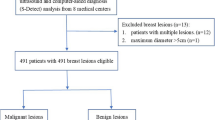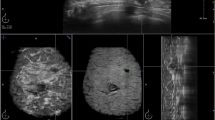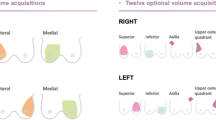Abstract
Objectives
To evaluate the diagnostic value of computer-aided diagnosis (CAD) software on ultrasound in distinguishing benign and malignant breast masses and avoiding unnecessary biopsy.
Methods
This prospective, multicenter study included patients who were scheduled for pathological diagnosis of breast masses between April 2019 and November 2020. Ultrasound images, videos, CAD analysis, and BI-RADS were obtained. The AUC, accuracy, sensitivity, specificity, PPV, and NPV were calculated and compared with radiologists.
Results
Overall, 901 breast masses in 901 patients were enrolled in this study. The accuracy, sensitivity, specificity, PPV and NPV of CAD software were 89.6%, 94.2%, 87.0%, 80.4%, and 96.3, respectively, in the long-axis section; 89.0%, 91.4%, 87.7%, 80.8%, and 94.7%, respectively, in the short-axis section. With BI-RADS 4a as the cut-off value, CAD software has a higher AUC (0.906 vs 0.734 vs 0.696, all p < 0.001) than both experienced and less experienced radiologists. With BI-RADS 4b as the cut-off value, CAD software showed better AUC than less experienced radiologists (0.906 vs 0.874, p < 0.001), but not superior to experienced radiologists (0.906 vs 0.883, p = 0.057). After the application of CAD software, the unnecessary biopsy rate of BI-RADS categories 4 and 5 was significantly decreased (33.0% vs 11.9%, 37.8% vs 14.5%), and the malignant rate of biopsy in category 4a was significantly increased (11.6% vs 40.7%, 7.4% vs 34.9%, all p < 0.001).
Conclusions
CAD software on ultrasound can be used as an effective auxiliary diagnostic tool for differential diagnosis of benign and malignant breast masses and reducing unnecessary biopsy.
Clinical trial registration
ClinicalTrials.gov (NCT 03887598)
Key Points
• Prospective multicenter study showed that computer-aided diagnosis software provides greater diagnostic confidence for differentiating benign and malignant breast masses.
• Computer-aided diagnosis software can help radiologists reduce unnecessary biopsy.
• The management of patients with breast masses becomes more appropriate.




Similar content being viewed by others
Abbreviations
- AUC:
-
Area under the receiver operating characteristic curve
- BI-RADS:
-
Breast Imaging Reporting and Data System
- CAD:
-
Computer-aided diagnosis
- NPV:
-
Negative predictive value
- PPV:
-
Positive predictive value
- US:
-
Ultrasound
References
Sung H, Ferlay J, Siegel RL et al (2021) Global cancer statistics 2020: GLOBOCAN estimates of incidence and mortality worldwide for 36 cancers in 185 countries. CA Cancer J Clin. https://doi.org/10.3322/caac.21660
World Health Organization (2014) WHO Position Paper on Mammography Screening. World Health Organization, Geneva. Available via https://www.ncbi.nlm.nih.gov/books/NBK269545. Accessed 25 Apr 2021
Oeffinger KC, Fontham ET, Etzioni R et al (2015) Breast Cancer Screening for Women at Average Risk: 2015 Guideline Update From the American Cancer Society. JAMA 314:1599–1614
Kolb TM, Lichy J, Newhouse JH (2002) Comparison of the performance of screening mammography, physical examination, and breast US and evaluation of factors that influence them: an analysis of 27,825 patient evaluations. Radiology 225:165–175
Schäfgen B, Juskic M, Radicke M et al (2021) Evaluation of the FUSION-X-US-II prototype to combine automated breast ultrasound and tomosynthesis. Eur Radiol 31:3712–3720
Lin X, Jia M, Zhou X et al (2021) The diagnostic performance of automated versus handheld breast ultrasound and mammography in symptomatic outpatient women: a multicenter, cross-sectional study in China. Eur Radiol 31:947–957
Hooley RJ, Scoutt LM, Philpotts LE (2013) Breast ultrasonography: state of the art. Radiology 268:642–659
D’Orsi C, Sickles E, Mendelson E, Morris E (2013) ACR BI-RADS® Atlas, breast imaging reporting and data system, 5th edn. American College of Radiology, Reston
Elverici E, Barça AN, Aktaş H et al (2015) Nonpalpable BI-RADS 4 breast lesions: sonographic findings and pathology correlation. Diagn Interv Radiol 21:189–194
Choi JS, Han BK, Ko ES et al (2019) Effect of a deep learning framework-based computer-aided diagnosis system on the diagnostic performance of radiologists in differentiating between malignant and benign masses on breast ultrasonography. Korean J Radiol 20:749–758
Wei Q, Zeng SE, Wang LP et al (2020) The value of S-Detect in improving the diagnostic performance of radiologists for the differential diagnosis of thyroid nodules. Med Ultrason 22:415–423
Kim K, Song MK, Kim EK, Yoon JH (2017) Clinical application of S-Detect to breast masses on ultrasonography: a study evaluating the diagnostic performance and agreement with a dedicated breast radiologist. Ultrasonography 36:3–9
Cho E, Kim EK, Song MK, Yoon JH (2018) Application of computer-aided diagnosis on breast ultrasonography: evaluation of diagnostic performances and agreement of radiologists according to different levels of experience. J Ultrasound Med 37:209–216
Di Segni M, de Soccio V, Cantisani V et al (2018) Automated classification of focal breast lesions according to S-detect: validation and role as a clinical and teaching tool. J Ultrasound 21:105–118
Zhao C, Xiao M, Liu H et al (2020) Reducing the number of unnecessary biopsies of US-BI-RADS 4a lesions through a deep learning method for residents-in-training: a cross-sectional study. BMJ Open 10:e035757
Wang XY, Cui LG, Feng J, Chen W (2021) Artificial intelligence for breast ultrasound: an adjunct tool to reduce excessive lesion biopsy. Eur J Radiol 138:109624
Lee SH, Chung J, Choi HY et al (2017) Evaluation of screening us-detected breast masses by combined use of elastography and color Doppler US with B-Mode US in women with dense breasts: a multicenter prospective study. Radiology 285:660–669
DeLong ER, DeLong DM, Clarke-Pearson DL (1988) Comparing the areas under two or more correlated receiver operating characteristic curves: a nonparametric approach. Biometrics 44:837–845
Jalalian A, Mashohor S, Mahmud R, Karasfi B, Saripan MIB, Ramli ARB (2017) Foundation and methodologies in computer-aided diagnosis systems for breast cancer detection. EXCLI J 16:113–137
Choi JH, Kang BJ, Baek JE, Lee HS, Kim SH (2018) Application of computer-aided diagnosis in breast ultrasound interpretation: improvements in diagnostic performance according to reader experience. Ultrasonography 37:217–225
Zhao C, Xiao M, Jiang Y et al (2019) Feasibility of computer-assisted diagnosis for breast ultrasound: the results of the diagnostic performance of S-detect from a single center in China. Cancer Manag Res 11:921–930
Wu JY, Zhao ZZ, Zhang WY et al (2019) Computer-aided diagnosis of solid breast lesions with ultrasound: factors associated with false-negative and false-positive results. J Ultrasound Med 38:3193–3202
Xiao M, Zhao C, Li J et al (2020) Diagnostic value of breast lesions between deep learning-based computer-aided diagnosis system and experienced radiologists: comparison the performance between symptomatic and asymptomatic patients. Front Oncol 10:1070
Lee J, Kim S, Kang BJ, Kim SH, Park GE (2019) Evaluation of the effect of computer aided diagnosis system on breast ultrasound for inexperienced radiologists in describing and determining breast lesions. Med Ultrason 21:239–245
Yongping L, Juan Z, Zhou P, Yongfeng Z, Liu W, Shi Y (2020) Evaluation of the Quadri-planes method in computer-aided diagnosis of breast lesions by ultrasonography: prospective single-center study. JMIR Med Inform 8:e18251
Xiao M, Zhao C, Zhu Q et al (2019) An investigation of the classification accuracy of a deep learning framework-based computer-aided diagnosis system in different pathological types of breast lesions. J Thorac Dis 11:5023–5031
Menezes GLG, Pijnappel RM, Meeuwis C et al (2018) Downgrading of breast masses suspicious for cancer by using optoacoustic breast imaging. Radiology 288:355–365
Acknowledgements
The authors thank all radiologists of the hospitals for assisting with the collection of the imaging data used in this study.
Funding
This study has received funding from the Tongji Hospital (HUST) Foundation for Excellent Young Scientist (Grant No. 2020YQ01), National Natural Science Foundation of China (Grant No. 82071953), and Key R&D Projects of Science and Technology of Hubei Province in 2020 (Grant No. 2020BCB022).
Author information
Authors and Affiliations
Corresponding author
Ethics declarations
Guarantor
The scientific guarantor of this publication is Xin-Wu Cui.
Conflict of interest
The authors of this manuscript declare no relationships with any companies whose products or services may be related to the subject matter of the article.
Statistics and biometry
No complex statistical methods were necessary for this paper.
Informed consent
Written informed consent was obtained from all subjects (patients) in this study.
Ethical approval
Institutional Review Board approval was obtained.
Methodology
• prospective
• diagnostic or prognostic study
• multicenter study
Additional information
Publisher's note
Springer Nature remains neutral with regard to jurisdictional claims in published maps and institutional affiliations.
Rights and permissions
About this article
Cite this article
Wei, Q., Yan, YJ., Wu, GG. et al. The diagnostic performance of ultrasound computer-aided diagnosis system for distinguishing breast masses: a prospective multicenter study. Eur Radiol 32, 4046–4055 (2022). https://doi.org/10.1007/s00330-021-08452-1
Received:
Revised:
Accepted:
Published:
Issue Date:
DOI: https://doi.org/10.1007/s00330-021-08452-1




